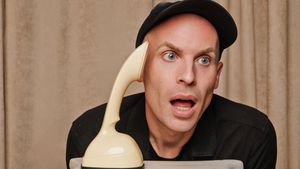You may have seen last week's headline "You Weren't Imagining It: More People are Having Gay Sex," which summarizes findings from our recent study that analyzed changes in both sexual behavior and public opinion toward individuals who engage in same-sex sexual behavior. Increases in both behavior and acceptance caught the attention of not only The Advocate but other major outlets as well: "Americans Are Sexually Experimenting Way More Than They Used To" and "More Americans Are OK With Same-Sex Experiences." So, what did we find, how did we find it, and why all the buzz? Perhaps the answer to the last question lies in what these findings could mean for the LGB community.
We looked at answers to questions in the General Social Survey, a nationally representative survey of Americans conducted every year or two since 1972, yielding responses from more than 30,000 Americans. We were interested in changes over time in reports of same-sex sexual behavior and attitudes about same-sex sexual behavior.
The survey asks people how they feel about "sexual relations between two adults of the same sex," with possible answers of "always wrong," "almost always wrong," "wrong only sometimes," and "not wrong at all." The survey began asking this question in 1973, when only 11 percent of Americans believed that same-sex sexual behavior was "not wrong at all." That number barely changed through the 1980s but began to climb steadily in the 1990s. Today, 49 percent of Americans believe that same-sex sexual relations are "not wrong at all," and 63 percent of young Americans (often dubbed millennials) report this highest level of acceptance. That's a huge increase in just 25 years!
We also found that the percentage of Americans who reported having had sex with at least one person of their same sex since the age of 18 has doubled. Since 1990, the number of women who reported having had sex with another woman rose from 3.6 percent to 8.7 percent. The same was true for men, with 4.5 percent of men in 1990 versus 8.2 percent of men today reporting same-sex sexual partners. Notably, Americans are increasingly reporting sex with both men and women, with the percentage of adults reporting sex with both men and women rising from 3.1 percent in 1990 to 7.7 percent in 2014. Does this mean that more people are identifying as lesbian, gay, or bisexual? This survey only began asking about sexual identity (with the options of gay, lesbian, bisexual, or heterosexual) in 2008 and, in 2014, 4.3 percent of the sample identified as gay, lesbian, or bisexual. Thus, about half of Americans reporting at least one same-sex sexual experience identify as heterosexual.
So what's going on? It's hard to tell from the data alone why these shifts have happened, though there are many possible reasons. Rising acceptance of same-sex sexual behavior may be related to the tremendous work of LGB rights activists around issues including marriage equality; inclusion and antidiscrimination policies in schools, government, and workplaces; HIV and AIDS; and the negative impact of discrimination, particularly on LGB youth. That work has helped more and more people become public about their same-sex attractions, behavior, and/or identity. The more people who are public, the more Americans report that they know someone who is gay, lesbian, or bisexual, which then helps to reduce prejudice. In social psychology, we call this "intergroup contact theory," which says that contact with people from other groups (racial groups, sexual orientation groups, etc.) helps reduce prejudice against that group. Simply put, there is likely a cascade effect here -- the more accepting we are, the more people are public about their lifestyle, and the public nature of their identities (including high-profile media figures) helps to further increase acceptance. These findings also fit into a larger narrative of a fundamental shift toward individualism, a cultural system that places more emphasis on the self and less on social rules. Although that system can lead to excessive self-focus (hello, selfies), it has also ushered in the unprecedented equality that follows when people are treated as individuals rather than as members of specific groups, such as gender or sexual orientation groups.
In terms of behavior, it makes sense that more people would be willing to act on their sexual attractions to people of the same sex if they believe that behavior is OK and that most other people are accepting. But we found that rising acceptance only partially explains the rise in same-sex sexual behavior. So what else is going on? Increased social and sexual networking options such as Manhunt, Grindr, and online dating sites, may provide more opportunity to meet same-sex sexual partners, perhaps more discreetly than ever before. Greater visibility in mainstream media of same-sex sexual experimentation and relationships may also provide models for people to follow. Some of the increase may also be due to Americans being more willing to admit to same-sex sexual behavior.
Regardless of why it's happening, these changing behaviors and attitudes (and increasing public awareness of them) likely have major implications for LGBT rights and equality. These changes speak to the current success of gay rights activists and also provide information about where future efforts are needed. For example, the largest increases in same-sex sexual behavior appeared in the South and the Midwest, perhaps because these regions were catching up to the coasts. These regions may be ripe for further change. We also found less change among black respondents and among those who are most religious. These findings highlight the need to work with religious and community leaders to increase empathy and acceptance in these populations. While that work is not easy or simple (for example, listen to a recent This American Life episode about a study aiming to change opinions around transgender issues), increasing acceptance and empathy are critical to improving the lives of LGBT Americans. Finally, our results, and the publicity around those results, are key in letting politicians and policy makers know who their constituents are and how they feel about these issues. Let's make sure they listen.
These findings are great news for the health of LGB Americans. Research shows that prejudice negatively impacts the health of LGB individuals, so changing social values should help improve both physical and mental health.
What does the future hold? As attacks on transgender and gender-nonconforming people increase and hate-based legislation is introduced around the country, these findings speak to the potential for change in attitudes towards those groups as well. Other commentators have likened the current backlash around transgender rights and protections to those we experienced earlier in our history regarding gay and lesbian rights and protections. We agree that we are on the brink of a rapid cultural change in our attitudes toward transgender and gender non-conforming persons, which likely helps explain the increase in reports of gender non-conformity, particularly among children and young adults.
Of course, there's still work to be done. Looking at all Americans, 51 percent still believe that same-sex sexual relations are at least sometimes wrong, though this number is much lower among young adults. Our hope is that this research will help to both celebrate our accomplishments and motivate continued efforts to increase empathy for, improve the health of, and increase legal and social protections for LGBT Americans. The more and better support we provide for LGBT people to be healthy and proudly open about their lives, the more we will humanize these issues and increase acceptance and empathy.
BROOKE E. WELLS is an associate professor at the Center for Human Sexuality Studies at Widener University. JEAN M. TWENGE is professor of psychology at San Diego State University and the author of Generation Me.


















































































